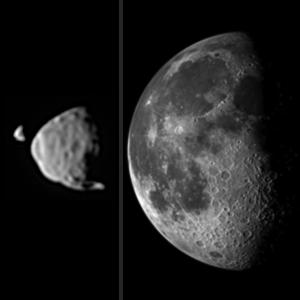English: PIA17351: Illustration Comparing Apparent Sizes of Moons
http://photojournal.jpl.nasa.gov/catalog/PIA17351
This image from NASA's Mars rover Curiosity provides a comparison for how big the moons of Mars appear to be, as seen from the surface of Mars, in relation to the size that Earth's moon appears to be when seen from the surface of Earth.
This illustration provides a comparison for how big the moons of Mars appear to be, as seen from the surface of Mars, in relation to the size that Earth's moon appears to be when seen from the surface of Earth. Earth's moon actually has a diameter more than 100 times greater than the larger Martian moon, Phobos. However, the Martian moons orbit much closer to their planet than the distance between Earth and Earth's moon.
Deimos, at far left, and Phobos, beside it, are shown together as they actually were photographed by the Mast Camera (Mastcam) NASA's Mars rover Curiosity on Aug. 1, 2013. The images are oriented so that north is up. The size-comparison image of Earth's moon, on the right, is also oriented with north up.
Deimos has a diameter of 7.5 miles (12 kilometers) and was 12,800 miles (20,500 kilometers) from the rover at the time of the image. Phobos has a diameter 14 miles (22 kilometers) and was 3,900 miles (6,240 kilometers) from the rover at the time of the image. Earth's moon has a diameter of 2,159 miles (3,474 kilometers) and is typically about 238,000 miles (380,000 kilometers) from an observer on Earth.
Malin Space Science Systems, San Diego, built and operates Mastcam. NASA's Jet Propulsion Laboratory manages the Mars Science Laboratory mission and the mission's Curiosity rover for NASA's Science Mission Directorate in Washington. The rover was designed, developed and assembled at JPL, a division of the California Institute of Technology in Pasadena.
For more about NASA's Curiosity mission, visit
http://www.jpl.nasa.gov/msl,
http://www.nasa.gov/mars, and
http://marsprogram.jpl.nasa.gov/msl.




